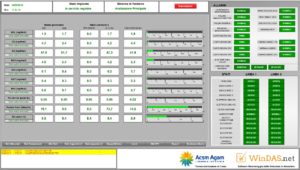
The data acquisition system WinDAS-03 stands for Windows Data Acquisition System Model 03. It was developed based on the professionalism and experience of BF Informatica technicians in the emissions monitoring field. Windas03 is software developed following ISPRA guidelines and the Legislative Decree dated 3 April 2006, no. 152 – Environmental standards, as specified better in this technical manual. The Windas system is a software package composed of multiple Windows applications (compatible with the XP/7/8/Server versions).
The data are acquired in direct mode by specific analysis tools with serial interfacing, Ethernet or through PLC interfaces. Data concentrators and acquisition cards assembled directly on the Personal Computer.
The data acquired, the alarm signalling and the results of calibrations detected are saved on a specific database. It is inside the hard disk of the personal computer.
The WinDAS-03 system makes available a vast assortment of functionalities in line. With user requirements to present and re-elaborate the data registered on the database. For example would be the re-elaboration of data registered, the creation of graphs or creation of customised reports.
WinDAS-03 includes a particular configuration of the WINDOWS operating system to enable automatic start-up of the programs.
-
BFLab Acquisition, validation and saving of data module

The BFLab application, built into the WinDAS-03 data acquisitions system, is dedicated to acquisition of data and automatic validation based on legislation in force. It is a flexible module since the defined configuration parameters enable management of various drivers for the acquisition of data directly from the field.
The list is provided below of some drivers for data acquisition:
- Decentralised peripherals and/or PLC: acquired from specific acquisition modules with Modbus and/or OPC protocol. They can also be interfaced with the main PLCs on the market;
- Calculated parameters. You can acquire a configuration parameter of the measures calculated, obtained from the measurements acquired from one or two tools. These measures are processed as values actually acquired by the tools;
- COM serial communication port. Using the communication protocol that the tool or the data concentrator makes available, simply specify the number and parameters of transmission of the serial port on the BFLab program via a configuration parameter. By doing so, you can acquire one or more measures (if planned by the tool) with an acquisition frequency established by the user. The capacity of the PC with a minimum acquisition frequency of 5 seconds determines the maximum limit of the tools which can be acquired by the BFLab program using a serial port.
- Data files saved on the hard disk of the personal computer. If the tool autonomously manages data acquisition and, then, saves them in a file (also through a specific external program), the name of the file must be specified to the BFLab program using a configuration parameter (you can also manage the data request file and a response file.). You can acquire one or more measures (if planned by the tool) with an acquisition frequency established by the user.
- Powders curve. You can, using a parameter that measures the opaqueness as a percentage, obtain the same
measurement but with a different unit of measurement (mg/Nm³) by applying the powders curve. To acquire the powder measurement in mg/Nm³ and to correctly execute the conversion, a table (powders measurement) is available in configuration. These measures are processed as values actually acquired by the tools.
- Analogue card inserted in the personal computer. You can acquire, with a frequency of 5 seconds, different measures read directly by the tools thanks to the various analogue channels made available by the card. Furthermore, if planned by the component, you can acquire different digital channels to
save the archive alarms (door open, high temperature, no power supply, etc.). As an optional, you can simulate the data (to execute saving tests when the card is not inserted in the PC) or acquire them from files by simulating acquisition from the analogue card with the same frequency.




